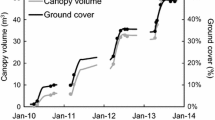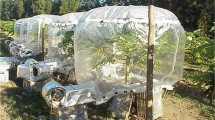Summary
The tree-trunk heat balance method with internal heating and sensing of temperature was used to estimate sap-flow rate of spruce trees in a stand in southern Sweden. Sap-flow rate values were scaled up to stand transpiration and utilised for calculation of canopy conductance. The calculated values provided the basis for a function relating canopy conductance to vapour pressure deficit, which was implemented in the Penman-Monteith equation. The stand was mostly growing in non-limiting soil water conditions (irrigation regime applied during dry periods). The whole-season transpiration was assessed by two different approaches and then compared: the sap-flow rate measurements were scaled to stand transpiration and the adapted Penman-Monteith estimate. They gave similar results: the transpiration totals differed by 3% and the coefficient of determination of the linear regression was r2 = 0.89. Similarly good was the assessment for a set of rainy days. The Penman-Monteith estimate adapted in this way proved to be reasonably precise and reliable in this forest stand and usable even in wet conditions. The seasonal transpiration of the spruce stand was 392 mm according to the adapted Penman-Monteith equation. Mean daily transpiration was 1.8 mm and daily maximum transpiration was 4.8–4.9 mm as estimated by sap-flow rate measurements.
Similar content being viewed by others
References
Baker JM, Van Bavel CHM (1987) Measurements of mass flow of water in the stems of herbaceous plants. Plant Cell Environ 10: 777–782
Bringfelt B, Lindroth A (1987) Synoptic evapotranspiration model applied to two northern forests of different density. J Hydrol 95: 185–201
Čermák J (1989) Solar equivalent leaf area: an efficient biometrical parameter of individual leaves, trees and stands. Tree Physiol 5: 269–289
Čermák J, Kučera J (1981) The compensation of natural temperature gradient in the measuring point during the sap flow rate determination in trees. Biol Plant 23: 469–471
Čermák J, Deml M, Penka M (1973) A new method of sap flow rate determination in trees. Biol Plant 15: 171–178
Čermák J, Kučera J, Bednářová (1980) Measurements and evaluation of transpiration of tree species on the site Mlynářův luh, Křivoklátsko. Final report to Central Institute for Geology, Praha Institute Forest Ecology, University of Agricultural Science, Brno (in Czech)
Čermák J, Úlehla J, Kučera J, Penka M (1982) Sap flow rate and transpiration dynamics in the full-grown oak (Quercus robur L.) in floodplain forest exposed to seasonal floods as related to potential evapotranspiration and tree dimensions. Biol Plant 24: 446–460
Čermák J, Jeník J, Kučera J, Žídek V (1984) Sap flow in a crack willow tree [Salix fragilis (L.)] in relation to diurnal changes of environment. Oecologia (Berl) 64: 145–151
Cohen Y, Fuchs M, Green GC (1981) Improvement of the heat pulse method for determining sap flow in trees. Plant Cell Environ 4: 391–398
Daum CR (1967) A method for determining water transport in trees. Ecology 48: 425–431
Gash JHC, Stewart JB (1975) The average surface resistance of a pine forest derived from Bowen ratio measurements. Boundary-Layer Meteorol 8: 453–464
Halldin S (1989) Willow stand evaporation: Simulation of diurnal distribution using synoptic weather data. In: Perttu KL, Kowalik PJ (eds) Modelling of energy forestry: growth, water relations and economics. Simulations Monographs 30. Pudoc, Wageningen, pp 121–146
Huber B (1928) Weitere quantitative Untersuchungen über das Wasserleitungssystem der Pflanzen. Jahrb Wiss Bot 67: 879–959
Jansson P-E, Halldin S (1979) Model for annual water and energy flow in layered soil. In: Halldin S (ed) Comparison of forest water and energy exchange models. International Soc Ecological Modelling, Copenhagen, pp 145–163
Jarvis PG, McNaughton KG (1986) Stomatal control of transpiration: scaling up from leaf to region. Adv Ecol Res 1: 1–45
Kaufmann MR, Kelliher FM (1991) Measuring transpiration rates. In: Lassoie JP, Hinckley TM (eds) Techniques and approaches in forest tree ecophysiology. CRC Press, Boca Raton, pp 117–140
Kučera J, Čermák J, Penka M (1977) Improved thermal method of continual recording of transpiration flow rate dynamics. Biol Plant 19: 413–420
Leverenz J, Deans JD, Ford ED, Jarvis PG, Milne R, Whitehead D (1982) Systematic spatial variation of stomatal conductance in a sitka spruce plantation. J Appl Ecol 19: 835–851
Lindroth A (1985) Canopy conductance of coniferous forests related to climate. Water Resour Res 21: 297–304
Lohammar T, Larsson S, Linder S, Falk S (1980) FAST-Simulation models of gaseous exchange in Scots pine. In: Persson T (ed) Structure and function of Northern coniferous forests — an ecosystem study. Ecol Bull 32: 505–523
Marshall DC (1958) Measurements of sap flow in conifers by heat transport. Plant Physiol 33: 385–396
Milne R (1989) Diurnal water storage in stems of 74 Picea sitchensis (Bong.) Carr. Plant Cell Environ 12: 63–72
Monteith JL (1965) Evaporation and atmosphere. In: Fogg GE (ed) The state and movement of water in living organisms. 19th Symp Soc Exp Biol, Cambridge. The Company of Biologists, Cambridge, pp 206–234
Morikawa Y, Hattori S, Kiyono Y (1986) Transpiration of a 31-year-old Chamaecyparis odtusa Endl. stand before and after thinning. Tree Physiol 2: 105–114
Pearcy RW, Schulze E-D, Zimmermann R (1991) Measurement of transpiration and leaf conductance. In: Pearcy RW, Ehleringer J, Mooney HA, Rundel PW (eds) Plant physiological ecology. Chapman and Hall, London, pp 137–160
Penman HL (1948) Natural evaporation from open water, bare soil and grass. Proc R Soc Lond Ser A 193: 120–146
Penman HL (1953) The physical basis of irrigation control. In: Synge PM (ed) Report of the Thirteenth International Horticultural Congress (1952), vol II. Royal Horticultural Society, London, pp 913–924
Roberts J (1983) Forest transpiration: a conservative hydrological process? J Hydrol 66: 133–141
Sakuratani T (1981) A heat balance method for measuring water flux in the stem of intact plants. J Agric Meteorol 34: 177–187
Schulze E-D (1986) Whole-plant responses to drought. Aust J Plant Physiol 13: 127–141
Schulze E-D, Čermák J, Matyssek R, Penka M, Zimmerman R, Vašícek F, Gries W, Kučera J (1985) Canopy transpiration and water fluxes in the xylem of the trunk of Larix and Picea trees — a comparison of xylem flow, porometer and cuvette measurements. Oecologia (Berl) 66: 475–483
Slavík B (1974) Methods of studying plant water relations. Academia Prague, Prague
Swanson RH (1983) Numerical and experimental analyses of implanted-probe heat pulse velocity theory. PhD Thesis, Department of Botany, Edmonton, Alberta
Türc L (1961) Evaluation des besoins en eau d'irrigation evapotranspiration potenielle. Ann Agron 12: 13–49
Whitehead D, Jarvis PG (1981) Coniferous forests and plantations. In: Kozlowski TT (ed) Water deficits and plant growth. Academic Press, New York, pp 49–152
Wronski EB, Holmes JW, Turner NC (1985) Phase and amplitude relations between transpiration, water potential and stem shrinkage. Plant Cell Environ 8: 613–622
Author information
Authors and Affiliations
Rights and permissions
About this article
Cite this article
Cienciala, E., Lindroth, A., Čermák, J. et al. Assessment of transpiration estimates for Picea abies trees during a growing season. Trees 6, 121–127 (1992). https://doi.org/10.1007/BF00202427
Received:
Accepted:
Issue Date:
DOI: https://doi.org/10.1007/BF00202427




